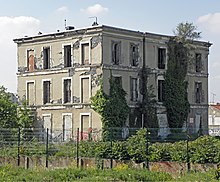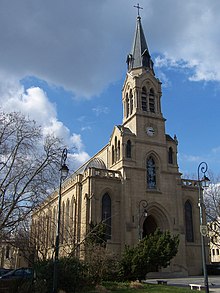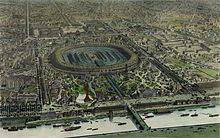François Coignet
François Coignet (also: Jean François Coignet ; born February 11, 1814 in Lyon , † October 30, 1888 in Saint-Denis ) was a French entrepreneur and civil engineer . He was a pioneer of concrete construction.
Family and career beginnings
François Coignet's father came from Lyon, was a druggist and, together with his father-in-law, had founded a chemical factory there in 1818. At the beginning gelatine was produced here, later also glutin glue and noir animal , an organic fertilizer made from residues of glue production, as well as ammonia and phosphorus compounds . The range of products indicates that animal bones were used here. The phosphorus was used to make fertilizers and matches .
François Coignet was trained at the École de la Martinière in Lyon with a scientific and technical focus, including chemistry , and then began to work in the family's chemical factory in Lyon .
François Coignet married his first wife, Célestine Delorme, in 1837, who died in 1846. In 1850 he married Clarisse Gauthier, a niece of Clarisse Vigoureux, who had been with Victor Considerant for many years . From this second marriage came Edmond Coignet (1856-1915).
Political and social engagement
Coignet was a supporter of the social reformer and early socialist Charles Fourier . He published several reform proposals, especially on the credit system and trade, some of which were also published in German . In contrast to Fourier, he was not interested in social utopias, but in practical improvements, insurance, cheap loans, the promotion of agriculture and the expansion of the railroad. He supported the February Revolution in 1848 , which introduced the Second Republic , and was involved in the republican Commission pour l'organization du travail in Lyon, whose position paper, signed by Coignet, was presented to the constituent assembly in Paris in 1848. After the failure of the Second Republic, Coignet found himself isolated in conservative Lyon and in 1851 moved with his second wife, who shared his political views, to St. Denis near Paris, where the company had a branch.
Professional background
The family business Coignet
After the death of his father, François Coignet took over the management of the company with his brothers Louis (* 1819) and Stéphane (* 1820) in 1846, which was then renamed Société Coignet père et fils . The factory expanded at an unusual rate. The share assets amounted to:
| year | Share capital | annotation |
|---|---|---|
| 1818 | 30,000 | |
| 1857 | 857,000 | |
| 1867 | 5,600,000 | In 1868 the turnover was 8 million francs |
| 1878 | 6,000,000 |
The factory diversified its product range and sales markets, and it was the market leader in France in the field of phosphorus production. The fact that she bought and exploited the French patent from Johan Edvard Lundström (1815–1888) for safety matches was also instrumental in the success .
concrete
From the mid-1840s Coignet experimenting with a modeled after the Stampflehms developed stamped concrete , which he described as aggloméré concrete designated. He patented numerous procedures and applications, for example in house construction, but also for public projects such as railway and hydraulic engineering, coastal protection and defense systems.
A report in the magazine L'Ingénieur from November 1855 on the occasion of the world exhibition in Paris , at which Coignet was allowed to present his concrete to a limited extent, discusses the advantages of the material and highlights its economic importance: The massive concrete retaining wall of the Maison Coignet , des François Coignet's private estate, cost only 5,000 francs instead of the normally estimated 18,000 francs (in brick construction) or 35,000 francs (in stone).
The new factory in St. Denis was built largely from concrete, which, given the flammable chemicals processed there, was also an advertisement for one of the advantages of the new building material. The complex also included workers' apartments - of course also made of concrete (59–61, Rue Charles Michels). In order to prove the suitability of the new, inexpensive material for residential buildings, he built his prestigious house designed by Théodore Lachèz in Saint-Denis (29 Boulevard de la Liberation) near the factory in 1852/53 entirely from concrete. It has been under monument protection as a monument historique as a cultural monument since 1998 .
In the early 1860s he founded a new subsidiary, Société centrale des bétons agglomérés . Coignet's patents already showed reinforcement made of iron rods and iron wires, arranged crosswise and used in the manufacture of ceilings, pipes, beams and columns. In 1861 he published the first book on reinforced concrete Les bétons agglomérés appliqué à l'art de construire . He is therefore considered to be one of the inventors of reinforced concrete even before Joseph Monier . He was able to win large public construction projects, such as the bank fortifications of Saint-Jean-de-Luz and the construction of the aqueduct over the Yonne for a water pipeline to Paris. The central arch with a span of 40 meters only succeeded after a collapse, a second attempt and two subsequent repairs.
Coignet accompanied his entrepreneurial activity with numerous publications that presented the advantages of concrete as a building material, initially with smaller brochures, then in 1861 with Les bétons agglomérés , his main work on this subject. An important branch of production were ornamented prefabricated parts made of artificial stone , such as window frames , stairs or railings, which were much cheaper to manufacture from concrete than from hewn natural stone. It was also possible to color the concrete and match it with natural stone. Coignet profited enormously from the lush construction boom that the rebuilding of Paris by Napoleon III. and Georges-Eugène Haussmann triggered. He supplied 30 km of concrete pipes for the sewer system in Paris and the 19 hectare tank for the Upper Lake in the Bois de Boulogne was also built by his company. In addition, he supplied concrete pipes for the sewer systems in Lyon, Marseille , Bordeaux , Dieppe , Mulhouse and Odessa , a total of more than 300 km, and had them laid.
During the construction of the Sainte-Marguerite church in Le Vésinet (1862–65), Goignet clashed with the architect, Louis-Auguste Boileau . The Coignet system was probably chosen, contrary to the wishes of the architect, for reasons of cost, to produce the outer shell of the church - an autonomous iron structure was the supporting structure. As the concrete became damp, discolored and showed shrinkage cracks, Boileau criticized the Coignet system as unsuitable for architectural construction. He even went so far as to build the same church again in Montluçon (Saint Paul), but to brick the cladding here.
Buildings (selection)

- 1852: Residence for the Suresnes station master
- 1853: Maison Coignet in Saint-Denis , 29 Boulevard de la Liberation
- 1856: Workers' house in Saint-Denis, 59-61 Rue Charles-Michels
- 1857: Pavilion in Saint-Denis, 75 Rue Charles-Michels
- from 1857: Saint-Jean-de-Luz bank fortifications
- 1860–1875: Opéra Garnier , foundation and stairs
- 1862–65: Church of Sainte-Marguerite in Le Vésinet (architect: Louis-Auguste Boileau )
- 1867: Five-storey house at 92, Rue de Miromesnil, Paris
- 1868/69: Port Said lighthouse (height: 55 m)
- Before 1870: the 19-hectare bath for the Upper Lake in the Bois de Boulogne
- 1870–1872: Aqueduct of the Parisian aqueduct over the Yonne
- 1872: Coignet Stone Company Building in New York (Architect: William Field and Son)
- Second half of the 1870s: blocks 7, 9, 11, rue Tocqueville / 9, 11, 13, rue de la Terrasse / 16, 18, 20, avenue des Villiers in Paris
Restructuring
In 1863 the concrete business was spun off from the chemical business and incorporated into the independent company François Coignet, frères et Cie. collected. This was renamed Société centrale des bétons aggloméré système Coignet in 1864 , one of the first to be set up as a limited liability company in France . In 1867 this company was busy building the foundations and the underground ventilation system for the exhibition building for the 1867 World's Fair , when the client, the city of Paris, suspended its payments for years. Bridging loans brought the company into the red. The Franco-German War that broke out in 1870 brought the construction business to a complete standstill. In addition, after the disaster with the Sainte-Marguerite church in Le Vésinet, the public sector became very reluctant to award contracts to Coignet. In 1871 Coignet resigned from the company and resigned. The construction business was given up. The company probably continued to exist with the sole business purpose of administering the block of houses Rue Tocqueville / Rue de la Terrasse / Avenue des Villiers in Paris. The Coignet chemical plant bought the St. Denis factory back as real estate.
In 1872 François Coignet founded the company Coignet Père et fils & Cie. Together with his son Edmond . , which resumed the production of concrete and concrete components and after the death of François Coignet in 1888 as Edmond Coignet et Cie. continued to be present at the hardware store. She also exhibited again at the World Exhibition in 1878 . Edmond turned away from the stamped concrete and opted for reinforced concrete . With the architect Jacques Hermant he erected two of the first reinforced concrete buildings in Paris: the former department store Aux Classes Laborieuses (85–87 Rue du Faubourg Saint-Martin) and the Salle Gaveau (Rue Saint-Honoré). The company continues to exist as Construction Edmond Coignet , but is now more involved in the renovation of older buildings.
Web links
- Information on François Coignet in the database of the Bibliothèque nationale de France .
literature
François Coignet has written numerous papers on both socio-economic and engineering topics, such as: B .:
Literature by François Coignet
Engineering publications (selection)
- Les bétons agglomérés appliqué à l'art de construire. Mémoire adressé à la commission des arts insalubres de l'Académie des sciences, pour concourir au prix Monthyon . Impr. De G. Jousset, Paris 1861.
Socio-economic publications (selection)
- Réforme du credit et du commerce, appel à tous les producteurs manufacturiers et agricoles . Librairie sociétaire, Paris 1849 = reform of credits and trade. Call to all tradespeople u. Agriculture . Edited for Germany by Josef Leopold Stiger. Matthes, Leipzig 1850.
- Socialisme appliqué au credit, au commerce, à la production, à la consommation . Librairie phalanstérienne, Paris 1849 = Socialism in its application to credit and trade. According to Fourier's principles . Translated from the French by Karl Bürkli . Mahler & Weber, Zurich, 1st edition: 1851; 2nd ed. 1855.
Literature on François Coignet
in alphabetical order by authors / editors
- Jean-Louis Bosc, J.-M. Chauveau et al: Joseph Monnier et la renaissance du béton armé. Editions du Linteau, Paris 2001, ISBN 2-910342-20-4 .
- Bernard Desmars: Coignet, (Jean-) François. on CharlesFourier.fr, July 2012 (French)
- Antoine Picon (ed.): L 'art de l'ingénieur. Constructeur, entrepreneur, inventor. Center Georges Pompidou et al., Paris 1997, ISBN 2-85850-911-5 (exhibition catalog, June 25 - September 29, 1997).
-
Ferdinand Werner : The long way to new building . Wernersche Verlagsgesellschaft, Worms 2016. ISBN 978-3-88462-372-5
- Volume 1: Concrete: 43 men invent the future .
- Volume 2: cement and artificial stone. The triumph of the imagination .
Remarks
- ^ In the literature there is also the following information: * February 10, 1814 in Lyon ; † October 29, 1888 in Paris (Werner, p. 80 and note 259 with reference to further literature).
- ↑ Although the building is sometimes referred to in literature as the oldest surviving concrete building of modern times, it is not. This record belongs to the Villa Lebrun (Werner, p. 80).
- ↑ Coignets Parisian apartment was located in the immediate vicinity in 98, Rue de Miromesnil (Werner, p 87).
Individual evidence
- ↑ Werner, p. 80ff.
- ↑ Information on François Coignet in the database of the Bibliothèque nationale de France , accessed on February 13, 2016.
- ↑ Boissingault and Payen : About the types of fertilizer and their relative value. First treatise. In: Journal for practical chemistry , Volume 29, 1843, pp. 90-127, p. 116.
- ↑ Werner, p. 80.
- ↑ Werner, p. 80.
- ↑ See also in the following: Bernard Desmars: Coignet, (Jean-) François. CharlesFourier.fr, July 2012 (French, accessed February 13, 2016).
- ↑ See section “Literature by François Coignet”.
- ↑ Werner, p. 81.
- ^ François Coignet (signatory): Projet d'association libre et volontaire entre patrons et ouvriers et de réforme commerciale présenté aux Comités du travail et de l'agriculture de l'Assemblée nationale au nom du Comité du travail de Lyon. Published by Impr. Lange Lévy , Paris 1848.
- ↑ Werner, p. 80.
- ↑ Werner, p. 85.
- ↑ cf. Michel Laferrère: Les industries chimiques de la région lyonnaise. In: Revue de geographie de Lyon 1952, vol. 27, pp. 219-256 (French, accessed on February 13, 2016).
- ↑ Werner, p. 80.
- ↑ Werner, p. 83.
- ↑ Werner, p. 83.
- ↑ Werner, p. 84.
- ↑ cf. Constructions économiques en béton pisé de M. Coignet. In: L'Ingénieur, November 1, 1855.
- ↑ Werner, p. 83.
- ↑ Werner, p. 103.
- ↑ Ancienne usine Coignet (Ref. PA93000010) in the Base Mérimée of the French Ministry of Culture (French).
- ↑ Werner, p. 97ff.
- ↑ Peter Marti, Orlando Monsch, Birgit Schilling: Ingenieur-Betonbau = series of publications by the Society for Civil Engineering 7. Zurich 2005. ISBN 3-7281-2999-2 , p. 30.
- ↑ Werner, p. 108ff.
- ↑ Werner, p. 84; see section “Engineering publications” below.
- ↑ Werner, p. 85.
- ↑ Werner, p. 86.
- ↑ Werner, p. 106f.
- ↑ Werner, p. 107f.
- ↑ Werner, p. 86.
- ↑ Hervé Guénot: Une réhabilitation béton in Saint-Denis. LeMoniteur.fr, February 17, 2014 (French, accessed February 13, 2016).
- ↑ Ancienne usine Coignet (Ref. PA93000011) in the Base Mérimée of the French Ministry of Culture (French).
- ↑ Werner, p. 86.
- ↑ Eglise Sainte-Marguerite (Ref. PA00087778) in the Base Mérimée of the French Ministry of Culture (French).
- ↑ Werner, p. 105ff.
- ↑ a b c Le béton armé “modern”: 1.2.1 François Coignet: précurseur de l'industrialization. Website for a DVD produced by L'Ecole Française du Béton and the Direction de l'architecture et du patrimoine (French, accessed February 13, 2016).
- ↑ Werner, p. 86.
- ↑ Werner, p. 108ff.
- ^ Coignet Stone Company Building. Website CityLandNYC.org the New York Law School (English, accessed on 13 February 2016).
- ↑ Werner, p. 113ff.
- ↑ Werner, p. 117.
- ↑ Werner, p. 118.
| personal data | |
|---|---|
| SURNAME | Coignet, François |
| BRIEF DESCRIPTION | French construction engineer and contractor |
| DATE OF BIRTH | February 11, 1814 |
| PLACE OF BIRTH | Lyon |
| DATE OF DEATH | October 30, 1888 |
| Place of death | Saint-Denis |



